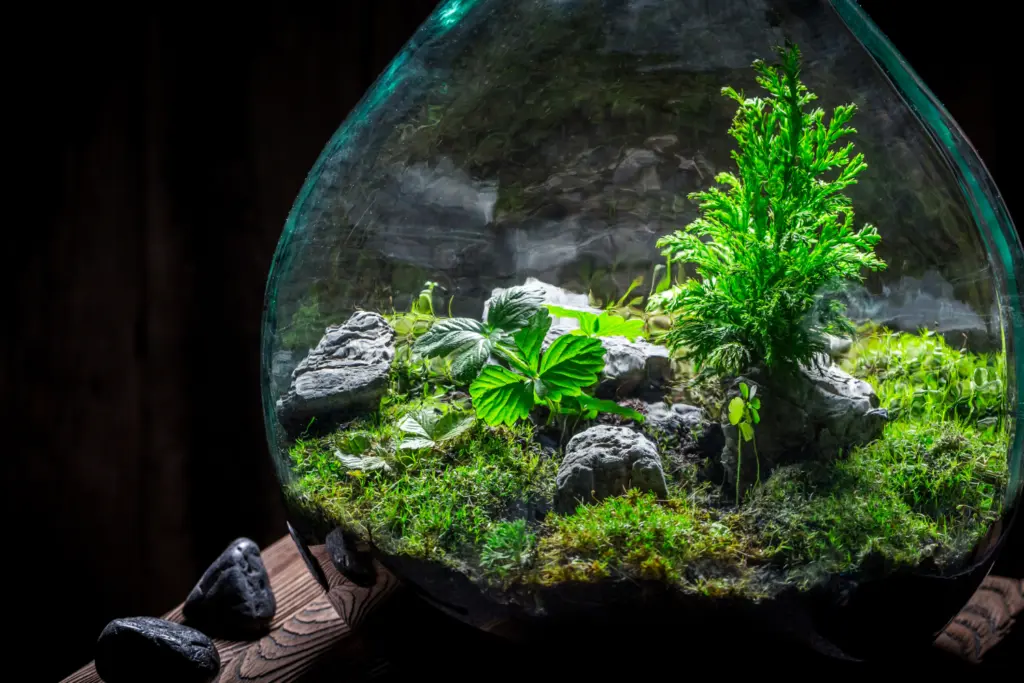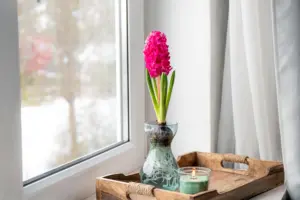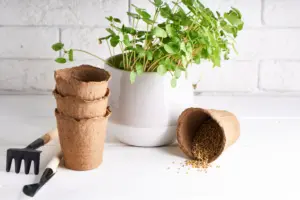
Watering a closed terrarium seems a bit counter intuitive, as they are meant to have their own water cycle. This means you water them when you plant them and then they effectively water themselves because of their internal water cycle.
The thing is, the ecosystem of a closed terrarium is small and fragile. This means even the slightest variation to that ecosystem can affect the water table and you might need to help it out. A reduction in water levels, for whatever reason, can mean your plants aren’t getting the nutrients they need.
Don’t worry though, closed terrariums are still very low maintenance indoor gardens. You certainly won’t find yourself needing to water your closed terrarium often. There are however signs that you need to look out for to see if you need to water your closed terrarium.
The signs you need to water your closed terrarium
The ecosystem in your closed terrarium will visually change if it isn’t getting enough water. There are 4 main things that you can look out for in your closed terrarium.
Moss
If you have moss in your closed terrarium, you will notice that when it is healthy it is a lush green color, no matter the species. When moss starts to yellow, or brown at the tips, this can be a sign that it is lacking in moisture.
If you notice this happening to the moss in your closed terrarium you need to open it up and check the moisture levels. Just as you would when checking moisture levels in an open terrarium you would put your finger into the soil to see how it feels. If it is dry your moss needs water, if not, you need to look for another reason.
Soil and substrate
The soil and substrate in a closed terrarium will be full and touch the sides of your container. It should look moist, (not saturated). If you start to notice that the soil and substrate are shrinking and no longer touch the sides of the container this is a sign that they can be drying out.
If this happens, again you need to open your closed terrarium and feel the soil in the same way as above.
Leaves
The normally green leaves of your healthy terrarium plants may begin to shrivel, droop or even turn brown at the ends if they need watering. You will notice that your plants leaves don’t seem to stand as firmly as they did before, and the plant will have that sad deflated look.
No condensation
Condensation is a big part of the water cycle in your closed terrarium as water that is in the humid air turns back to a liquid as it touches the container sides. This means you will see water droplets running down the side of your closed terrarium. If you can’t see those water droplets this is a sign that the water cycle isn’t working, and your plants may need watering.
How to Water a Closed Terrarium
Watering a closed terrarium is best done with a spray bottle. You need to be careful not to introduce too much water into the ecosystem if your terrarium, so it is best to add water slowly and in small amounts. When you open-up your closed terrarium, we advise giving your plants some time to breathe and taking your time with the watering process.
Use a mister, like this retro style plant mister from Amazon, to water your plants. This mister looks good and sprays a fairly even coverage. Consider only 1-2 sprays and then leave your terrarium open for a few hours before adding another spray and closing it back up. This allows dry plants and soil to absorb the moisture and adding another spray before closing helps to restart the water cycle faster.
Be careful not to overwater your terrarium, and of you don’t feel it needs the extra spray don’t do it. Over watering your terrarium can cause serious problems for your ecosystem and even cause your plants to die. Our article 10 signs you may be overwatering your closed terrarium (and some solutions) helps you spot the signs.
Remember to always monitor the health of the plants in your terrarium and use the opportunity of having the lid open to make any adjustments you might need to make.
Best water for a closed terrarium
The best water to use for watering your closed terrarium is either rainwater, distilled water or reverse osmosis water. If you’re budget and environmentally conscious rainwater is the best option and probably the healthiest option for your plants.
Reverse osmosis water and distilled water do not have the potentially planting harming chemicals in that tap water does. Although fine for humans to drink, it’s not the best option for watering your plants. We recommend gathering some rainwater and using that. You don’t need much, so you can even catch it on a window ledge.

3 top tips: how to water a closed terrarium
If you need to add water to your closed terrarium remember:
1: Never pour water into your container as it has no where to escape. It’s effectively like flooding your garden.
2: Closed terrariums will visually show you if they need watering.
3: Be patient when you water your closed terrarium, or you could be at risk of overwatering. This is because when water rapidly you won’t know whether the plants are absorbing the water.
Conclusion
You rarely have to water a closed terrarium, and when you do take your time. You don’t need to add too much water so consider using a mister for a light and even coverage. Watering your closed terrarium is infrequent and easy when you know how. Maintaining this precious little ecosystem in your home involves observing the changes and knowing when to act, while enjoying the beauty of your garden.








